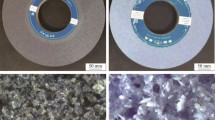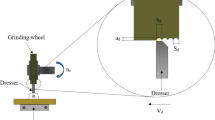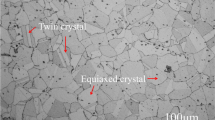Abstract
Residual stresses induced by finish machining processes have significant effect on fatigue strength of ultra-high strength steel in large structures. In this study, an experimental investigation was carried out to explore the residual stress and affected layer in grinding Aermet100 by using a resin bond white alumina (WA) wheel and cubic boron nitride (cBN) wheel, respectively. The grinding force and temperature were measured, and then the affected layer of residual stress, microhardness, and microstructure by a WA and a cBN wheel was obtained. The comparisons of surface residual stress studies and thermal–mechanical coupling mechanism on the affected layer were discussed in light of the current understanding of this subject. Experimental results show that grinding with cBN wheel can provide compressive residual stress and a smaller affected layer owing to its better thermal conductivity; the coupling effect of wheel speed and grinding depth plays a more significant role on surface residual stress; when grinding with parameters v w = 18 m/min, v s = 14 m/s, and a p = 0.01 mm, compressive residual stress and hardening effect appeared on ground surface, and the depth of residual stress layer is 40~50 μm; the depth of hardened layer is 30~40 μm and the depth of plastic deformation layer is 5~10 μm.
Similar content being viewed by others
References
Ko TJ, Kim HS (2001) Surface integrity and machinability in intermittent hard turning. Int J Adv Manuf Technol 18(3):168–175
Javidi A, Rieger U, Eichlseder W (2008) The effect of machining on the surface integrity and fatigue life. Int J Fatigue 30:2050–2055
Ding WF, Xu JH, Chen ZZ, Su HH, Fu YC (2010) Grindability and surface integrity of cast nickel-based superalloy in creep feed grinding with brazed CBN abrasive wheels. Chin J Aeronaut 23:501–510
Yao CF, Jin QC, Huang XC, Wu DX, Ren JX, Zhang DH (2013) Research on surface integrity of grinding Inconel718. Int J Adv Manuf Technol 65:1019–1030
Sasahara H (2005) The effect on fatigue life of residual stress and surface hardness resulting from different cutting conditions of 0.45 % C steel. Int J Mach Tools Manuf 45:131–136
Vashista M, Kumar S, Ghosh A, Soumitra P (2010) Surface integrity in grinding medium carbon steel with miniature electroplated monolayer cBN wheel. J Mater Eng Perform 19:1248–1255
Guo YB, Sahni J (2004) A comparative study of hard turned and cylindrically ground white layers. Int J Mach Tools Manuf 44:135–145
Umbrello D, Filice L (2009) Improving surface integrity in orthogonal machining of hardened AISI 52100 steel by modeling white and dark layers formation. CIRP Ann Manuf Technol 58(1):73–76
Umbrello D, Outeiro JC, M’Saoubi R, Jayal AD, Jawahir IS (2010) A numerical model incorporating the microstructure alteration for predicting residual stresses in hard machining of AISI 52100 steel. CIRP Ann Manuf Technol 59:113–116
Umbrello D (2011) Influence of material microstructure changes on surface integrity in hard machining of AISI 52100 steel. Int J Adv Manuf Technol 54:887–898
Coto B, Navas VG, Gonzalo O, Aranzabe A, Sanz C (2011) Influences of turning parameters in surface residual stresses in AISI 4340 steel. Int J Adv Manuf Technol 53:911–919
Su GS, Liu ZQ (2012) Wear characteristics of nano TiAlN-coated carbide tools in ultra-high speed machining of AerMet100. Wear 289:124–131
Kruszyński BW, WoÂjcik R (2001) Residual stress in grinding. J Mater Process Technol 109:254–257
El-Axir MH (2002) A method of modeling residual stress distribution in turning for different materials. Int J Mach Tools Manuf 42(9):1055–1063
Xu YQ, Zhang T, Bai YM (2012) Analysis of the surface residual stress in grinding Aermet100. Mater Sci Forum 704–705:318–324
Xu YQ, Zhang T, Bai YM (2010) Effect of grinding process parameters on surface layer residual stress. Adv Mater Res 135:154–158
Chen X, Rowe WB, Cai R (2002) Precision grinding using CBN wheels. Int J Mach Tools Manuf 42:585–593
Rowe WB, Black S, Mills B (1996) Temperature control in CBN grinding. Int J Adv Manuf Technol 12:387–392
Bosheh SS, Mativenga PT (2006) White layer formation in hard turning of H13 tool steel at high cutting speeds using CBN tooling. Int J Mach Tools Manuf 46(2):225–233
Author information
Authors and Affiliations
Corresponding author
Rights and permissions
About this article
Cite this article
Yao, C., Wang, T., Ren, J. et al. A comparative study of residual stress and affected layer in Aermet100 steel grinding with alumina and cBN wheels. Int J Adv Manuf Technol 74, 125–137 (2014). https://doi.org/10.1007/s00170-014-5955-8
Received:
Accepted:
Published:
Issue Date:
DOI: https://doi.org/10.1007/s00170-014-5955-8




